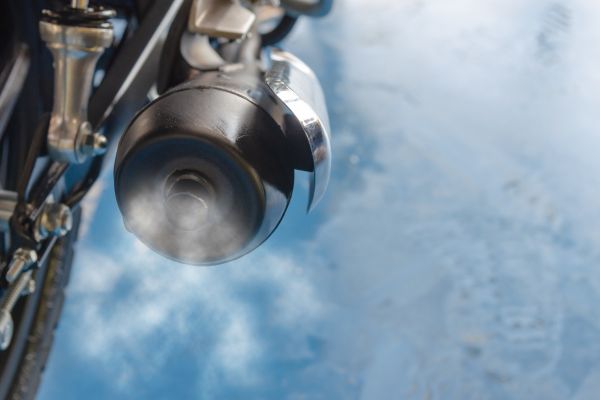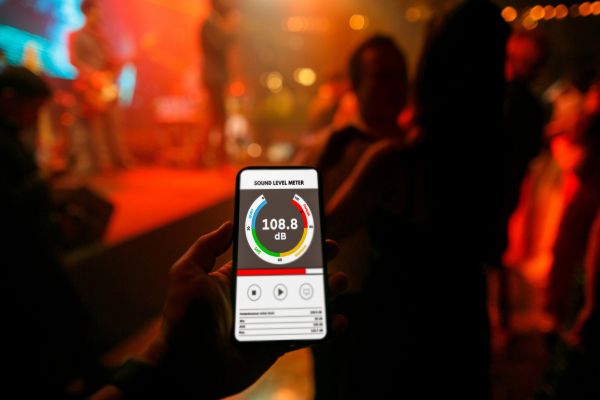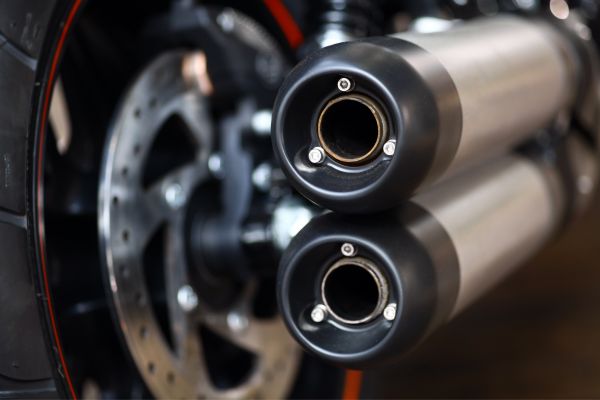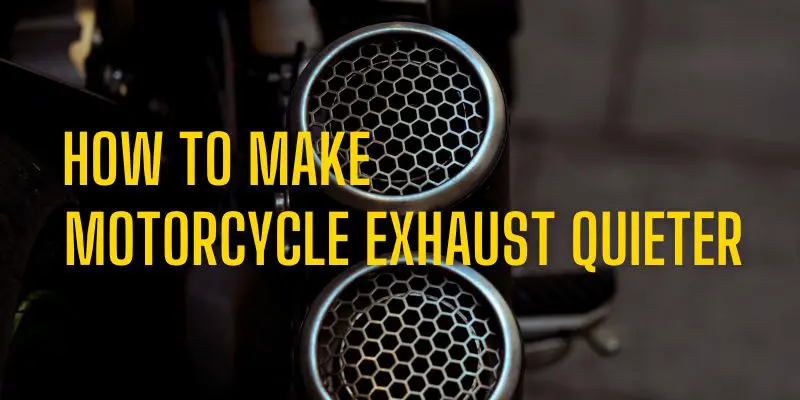Do you love the thrill of riding your motorcycle but find the loud exhaust noise to be bothersome or even illegal?
Luckily, you can make your motorcycle exhaust quieter without sacrificing performance or style in different manners.
Below, I’ll explore effective methods to reduce the sound of your motorcycle exhaust, so you can enjoy your rides without disturbing anyone or violating noise regulations.
Why your exhaust is louder | How to make the exhaust quieter | How to install bike silencer | Wrong length bike silencer | What’s too loud for a motorcycle | Tips & tricks
Why is My Motorcycle Exhaust Louder All of a Sudden

A motorcycle exhaust might suddenly become louder for several reasons, such as the following:
Damaged or Worn Out Muffler
The muffler is an essential component of your motorcycle exhaust system that helps reduce the engine’s noise. If the muffler is damaged or worn out, it may fail to muffle the sound, effectively leading to a louder exhaust.
Loose or Broken Exhaust Pipe
Over time, the exhaust pipe can become loose or develop cracks or holes; this can cause exhaust gases to escape before they reach the muffler, resulting in a louder exhaust note.
Aftermarket Exhaust System
If you recently installed an aftermarket exhaust system, it’s likely designed to provide better performance and a louder exhaust note.
Exhaust Leak
An exhaust leak can occur at any point in the exhaust system, such as where the exhaust manifold meets the engine or where the exhaust pipe connects to the muffler. An exhaust leak can cause a noticeable increase in exhaust noise.
Engine Tuning
If you recently had your motorcycle tuned or modified, that can result in a louder exhaust note.
Suppose you’re unsure what’s causing your motorcycle exhaust to suddenly become louder. In that case, it’s best to take it to a trusted mechanic who can diagnose the problem and suggest the necessary repairs.
Related: How to make your motorcycle exhaust sound deeper
How to Make Motorcycle Exhaust Quieter
If your motorcycle exhaust is too loud and you want to make it quieter, here’s a list of possible solutions you can try:
Remove Exhaust Leak
An exhaust leak is a common cause of increased exhaust noise.
The leak can occur at any point in the exhaust system. It can happen where the exhaust manifold meets the engine, or the exhaust pipe connects to the muffler.
The easiest way to fix an exhaust leak is to identify its location and repair it with a sealant or by replacing the damaged part.
Change Exhaust Pipes
Replace your loud aftermarket exhaust system with a quieter one. Look for pipes with a larger muffler or baffle specifically designed to reduce noise.
A larger muffler or baffle will help slow the exhaust gases down and reduce their pressure, resulting in a quieter exhaust note.
Ensure the exhaust system is compatible with your motorcycle for optimal performance.
Use Exhaust Wraps
Exhaust wraps can help to reduce noise by insulating the pipes and muffler. They also help keep heat in the pipes, improving performance.
The wrap is made of a heat-resistant material, such as fiberglass or ceramic, wrapped around the exhaust pipe or muffler. It’s important to wrap the exhaust system correctly to avoid damaging the pipes or muffler.
Get a Bike Silencer
A bike silencer, also known as a muffler insert, is a device that can be installed on your motorcycle to reduce the volume of the exhaust.
The silencer works by slowing down the exhaust gases and reducing their pressure, which results in quieter operation.
Bike silencers are available in various shapes and sizes, so choosing one compatible with your motorcycle is important.
Get a Better Bike Baffle
The baffle in your muffler can affect the volume of your exhaust.
If you have an aftermarket muffler, you can replace the baffle with a quieter one. The baffle is a component inside the muffler that helps control exhaust gas flow.
By choosing a baffle that’s designed to reduce noise, you can make your exhaust quieter without sacrificing performance.
Get a Better Catalytic Converter
A catalytic converter is an important component of the exhaust system that helps to reduce harmful emissions. It works by converting toxic gases into less harmful ones.
A high-quality catalytic converter can also help reduce your exhaust volume.
The converter’s efficiency can affect the exhaust sound, so if you have an old or failing catalytic converter, it could contribute to a louder exhaust.
Upgrading to a better quality converter can help to reduce exhaust noise.
Reduce Muffler Noise
Mufflers reduce the volume of exhaust noise by dissipating sound waves through a series of baffles or chambers.
If your muffler is too loud, you can try adding sound-deadening material to the inside or replacing the muffler with a quieter one. Many mufflers are designed to offer quieter operation while still providing good performance.
Some mufflers also have adjustable baffles that allow you to fine-tune the volume of the exhaust. Choose a muffler designed to fit your motorcycle and compatible with your exhaust system.
How to Install a Quiet Baffles
The installation of a bike silencer will vary depending on the make and model of your motorcycle and the type of silencer you have.
However, here’s a list of general steps that can help guide you through the installation process:
Step 1: Gather the Necessary Tools
Before starting the installation process, ensure you have all the necessary tools. These may include a wrench, pliers, screwdrivers, and any other tools specific to your bike or the silencer you have.
Step 2: Remove the Existing Exhaust System
If replacing the entire exhaust system, you’ll need to remove the old one first.
Start by loosening the clamps that hold the exhaust in place, and then remove any bolts or screws that connect the exhaust to the bike.
You may need to use pliers or a wrench to loosen the clamps.
Step 3: Install the Silencer
Once the old exhaust is removed, you can install the new silencer.
The installation typically involves connecting the silencer to the header pipe or muffler, depending on the design of your exhaust system.
Follow the manufacturer’s instructions carefully to ensure it’s installed correctly.
Step 4: Reattach the Exhaust System
After the silencer is installed, you can reattach the exhaust system to the bike. Make sure to tighten any clamps, bolts, or screws that hold the exhaust in place.
You may need to adjust the positioning of the exhaust to ensure that it doesn’t interfere with other components on the bike.
Step 5: Test the Silencer
Once the installation is complete, start the engine and listen for leaks or abnormal sounds. Take the bike for a test to ensure the silencer is functioning properly.
If you’re uncomfortable installing a bike silencer yourself, it’s recommended to have a professional mechanic or exhaust specialist do the installation for you to ensure it’s done correctly.
What if Your Bike Silencer Has the Wrong Length
If your bike silencer has the wrong length, it can cause many problems.
For example, if the silencer is too long, it may interfere with other components on the bike, such as the rear wheel or suspension.
On the other hand, if the silencer is too short, it may not effectively reduce exhaust volume.
If you’ve already bought a silencer that has the wrong length, here’s what you can do:
Return or Exchange the Silencer
If you purchased the silencer from a retailer, you might be able to return it for a refund or exchange it for a different size. Check the retailer’s return policy and applicable warranty before returning or exchanging the silencer.
Modify the Silencer
In some cases, you may be able to modify the silencer to make it work with your bike. For example, you could try cutting or welding the silencer to adjust its length. However, modifying the silencer can void any warranty and affect its performance.
Purchase a New Silencer
If you can’t return or modify the silencer, you may need to purchase a new one that is the correct length for your bike.
Carefully measure your exhaust system and consult an exhaust specialist or mechanic to ensure that you’re purchasing the right size. Choose a silencer that’s designed to fit your specific make and model of motorcycle.
Using a silencer that is the wrong length can cause many problems, including reduced performance, increased exhaust noise, and even damage to your bike’s components.
What is Too Loud For a Motorcycle

Determining what is “too loud” for a motorcycle can depend on various factors, including local noise regulations, personal preferences, and the specific motorcycle model.
However, generally, a motorcycle that produces excessive noise can be considered too loud if it meets any of the following criteria:
Violates Local Noise Regulations
Many cities and municipalities have noise ordinances that specify the maximum allowable noise levels for vehicles, including motorcycles.
If your motorcycle produces noise that exceeds these regulations, it may be considered too loud and subject to fines or other penalties.
Causes Discomfort or Disturbance
Even if your motorcycle doesn’t violate noise regulations, it may be considered too loud if it causes discomfort or disturbance to others.
For example, if your motorcycle produces a loud enough noise to wake up sleeping neighbors, it may be considered too loud.
Attracts Negative Attention
Riding a motorcycle that produces excessive noise can attract negative attention from law enforcement or other motorists, potentially leading to tickets, fines, or even impoundment.
It’s important to consider the potential consequences of riding a loud motorcycle before deciding whether it’s worth it.
Note that even if a motorcycle is technically within legal limits, it can still be considered too loud if it makes excessive noise that disrupts the peace of the surrounding environment.
It’s generally recommended to keep motorcycle exhaust volume reasonable.
Helpful Tips for Making Motorcycle Exhaust Quieter

Here are some additional tips that can help make your motorcycle exhaust quieter:
Avoid Revving the Engine
When you rev your engine, it can cause your exhaust to become louder, especially if you have an aftermarket exhaust system.
Try to avoid revving your engine unnecessarily to keep the exhaust volume down.
Use a Sound Deadening Mat
You can try using a sound-deadening mat if you’re looking for a more cost-effective option to reduce exhaust noise. These mats absorb sound waves and can be installed inside the muffler or outside the exhaust pipe.
Check Your Riding Style
Your riding style can also affect the volume of your exhaust. For example, if you tend to ride aggressively or accelerate quickly, you may produce more exhaust noise. Try to adopt a more conservative riding style to reduce exhaust noise.
Consider Adding a DB Killer
A DB killer is a device that can be added to your exhaust system to help reduce exhaust noise. It works by restricting the flow of exhaust gases and reducing the pressure and volume.
Use a Quiet Insert
Some aftermarket exhaust systems come with a quiet insert, which is designed to reduce the volume of the exhaust. If your exhaust system doesn’t have a quiet insert, you can purchase one separately and install it yourself.
Remember that making your motorcycle exhaust quieter can affect the performance of your bike. It’s important to choose the suitable method for your situation and consult a mechanic or exhaust specialist if you’re unsure what to do.
Conclusion
Reducing the noise of your motorcycle exhaust can be a simple and affordable process that doesn’t require professional help.
Applying some of the methods we’ve discussed allows you to enjoy a quieter and more comfortable ride while maintaining your motorcycle’s power and personality.
Always check your local laws and regulations regarding motorcycle noise before making any modifications.



